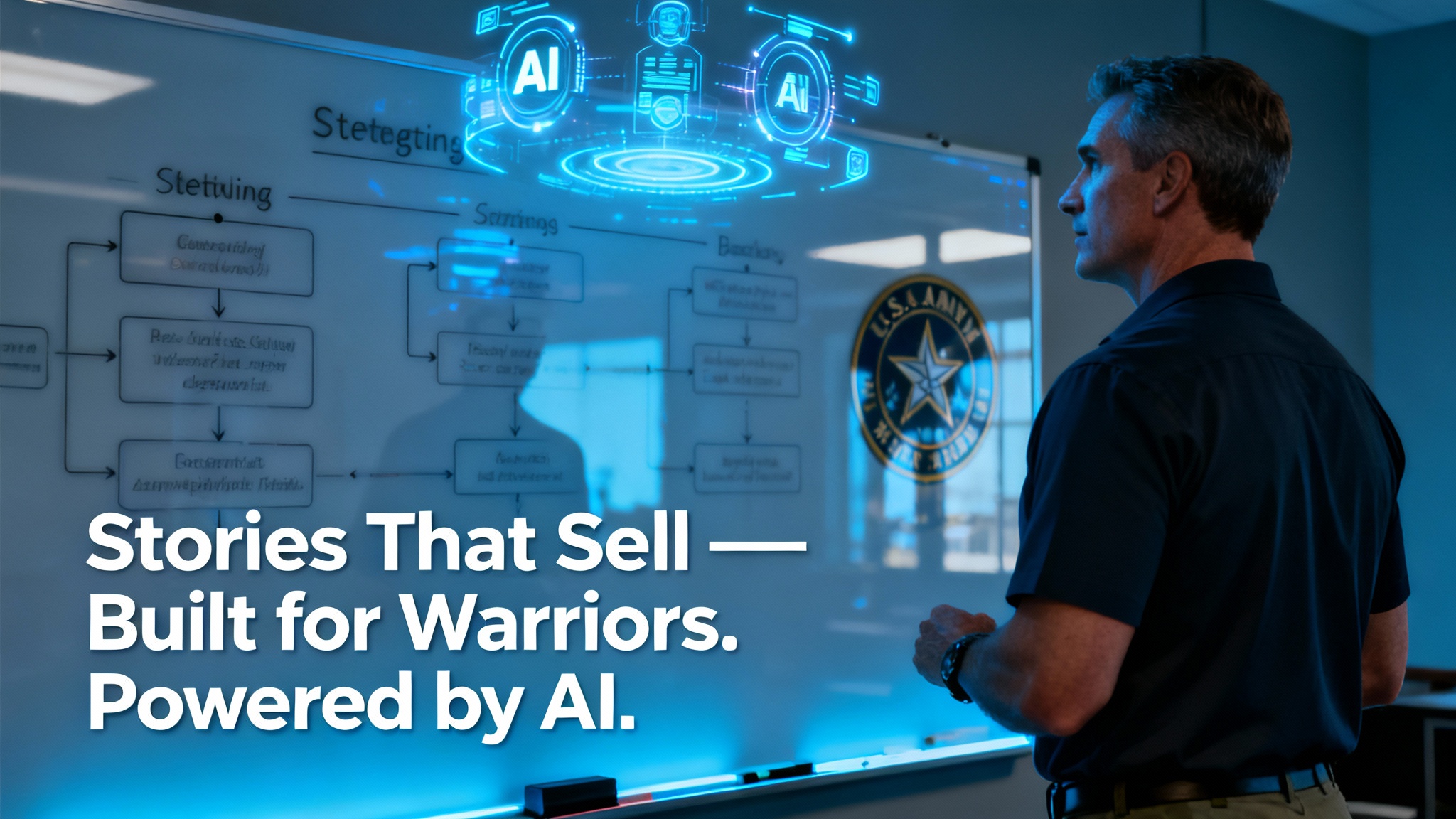Fun fact: the first time my email automation collapsed, I actually yelled, “Medic!” to an empty office. Running an AI business? It’s less about boardroom buzzwords and more about keeping your soldiers—or chatbots—in line. Here’s how trading in my uniform for a laptop taught me why AI entrepreneurship isn’t a desk job at all. It’s an operation—with every win (or tech failure) hard-earned.
From Barracks to Bots: Defining Your Mission, Assembling the Squad
Let’s be real: building an AI-powered business isn’t about “winging it” or hoping your tech stack magically sorts itself out. It’s about running your operation with the same discipline and clarity as a military mission. In the Army, every op starts with a clear objective, a chain of command, and a squad you trust with your life. In the world of AI business strategy, it’s no different—except your squad is made up of digital soldiers, not boots on the ground.
“Discipline is choosing between what you want now and what you want most.” – Abraham Lincoln
Mission First: Define Your Objective
Before you even think about which AI tools to deploy, you need a mission statement. What are you fighting for? Is it more leads, higher sales, or the ultimate prize—freedom from the daily grind? Your mission is your North Star, the thing that keeps you moving forward when the going gets tough (and trust me, it will).
- Lead Generation: Want to build a pipeline of prospects? Your mission is to capture attention and nurture relationships.
- Sales Domination: Ready to close deals on autopilot? Your mission is to convert interest into revenue.
- Freedom Ops: Dreaming of a business that runs itself? Your mission is to automate, delegate, and step back.
Write your mission down. Tape it to your monitor. This is your “why”—and every AI-powered agent you recruit should serve this objective.
Assembling the Digital Squad: AI Tools as Soldiers
In the military, you don’t send the cook to clear a building or the medic to lead a charge. You assign roles based on strengths and mission needs. The same goes for your AI business strategy. Here’s how I built my own Freedom Ops Command Center—and how you can assemble your squad:
- ChatGPT: The Intel Officer
Handles strategy, copywriting, and customer communication. Need sharp emails, blog posts, or chatbot scripts? ChatGPT’s on it, 24/7, no coffee breaks required. - Canva AI: The Graphics Specialist
Designs everything from social media posts to pitch decks. Canva AI makes your brand look sharp, even if you can’t draw a stick figure. - InVideo AI: The Combat Cameraman
Turns scripts into scroll-stopping videos. Perfect for social media, ads, or training content—no Hollywood budget needed. - Zapier/N8n: The Logistics Crew
Automates workflows, connects your apps, and keeps your operation running without human error. Think of them as the supply sergeants of your digital army.
Choose Your Squad Based on Strengths
Here’s the thing—no two squads are identical. Your strengths, business model, and mission will determine which AI tools entrepreneurs should deploy. Maybe you’re a killer on video but hate writing—lean on InVideo AI and let ChatGPT handle the words. Or maybe design is your jam, but you need help with automation—Canva AI and Zapier are your go-to.
By 2025, AI workplace transformation will be the norm, not the exception. Agentic AI—autonomous agents that handle complex tasks—are already reshaping how we approach business operations. The right squad lets you focus on leadership and decision-making, while your bots handle the grunt work.
The Freedom Ops Command Center: System & Mindset
Your command center isn’t just a dashboard—it’s a way of thinking. Every AI tool is a soldier with a job to do. Your job as commander is to set clear objectives, assign roles, and review the after-action reports (analytics). If a tool isn’t pulling its weight, swap it out. If your mission changes, adapt your squad.
- Clarity: Every tool serves the mission, not the other way around.
- Discipline: Stick to your SOPs (systems and processes), but stay flexible.
- Readiness: Always be ready to pivot—AI evolves fast, and so should you.
Remember, assembling your AI-powered agents isn’t about having the fanciest tech—it’s about building a team that aligns with your mission and strengths. That’s how you go from barracks to bots, and from chaos to command.

Standard Operating Procedures: Setting Funnels, Automations, and Follow-Ups Like a General
Let’s get one thing straight: in the Army, you don’t just “wing it.” You follow Standard Operating Procedures (SOPs) because lives—and missions—depend on it. In the world of AI business operations, your SOPs are your battle plans: funnels, automations, and analytics. These aren’t just fancy buzzwords; they’re the backbone of your digital command center. If you want to run your AI business like a military operation, you need discipline, consistency, and a little bit of that “never quit” attitude. So, grab your digital dog tags—let’s break down how to set up your battlefield blueprints for maximum AI business efficiency.
Adopt SOPs: Funnels, Automations, and Analytics as Your Battlefield Blueprints
Think of your funnels as the tactical routes your prospects take from first contact to mission accomplished (aka, the sale). Your automations are the grunts—handling repetitive tasks, following orders, and never asking for leave. And your analytics? That’s your after-action report, giving you the intel you need to adapt and win the next round.
- Funnels: Map out every step your lead takes. From landing page to email sequence to checkout, every click is a checkpoint.
- Automations: Use AI automation tools like Zapier, N8n, or Make to connect your systems. Let AI-powered agents handle customer onboarding, follow-ups, and even abandoned cart recovery.
- Analytics: Deploy AI decision intelligence platforms to monitor KPIs, conversion rates, and customer behavior. These insights are your battlefield recon—don’t ignore them.
"No plan survives first contact with the enemy, but good SOPs save the day."
Let AI Automation Tools Handle the Grunt Work
Here’s the beauty of AI automation tools: they don’t sleep, don’t eat, and don’t complain about the Wi-Fi. When I first started, I tried to do everything myself—writing emails, responding to leads, updating spreadsheets. It was like trying to clear a minefield with a spoon. Once I brought in AI, I could automate 95% of my operations (and yes, that’s a real number—veterans in the AI Freedom Launchpad community are doing it every day).
- ChatGPT: Your intel officer—drafts copy, answers FAQs, and even scripts your webinars.
- Canva AI: The graphics specialist—creates on-brand visuals in seconds.
- Zapier/N8n: The logistics crew—connects your apps, triggers workflows, and keeps the supply lines open.
With these tools in your arsenal, you’re not just working harder—you’re working smarter. That means more time for strategy, leadership, and, occasionally, actual sleep. Automation isn’t about replacing you; it’s about freeing you up to lead the mission.
Personal Anecdote: The 2 A.M. Funnel Fiasco
Let me tell you about the night I learned even robots need a backup plan. It was 0200 hours. I was dead asleep when my phone started lighting up like a Christmas tree. My funnel had failed—emails weren’t sending, leads were piling up, and my “unstoppable” automation had hit a digital IED. Turns out, even the best AI systems need regular checks and redundancies. Lesson learned: always have a manual override and a backup plan, just like in the field.
After-Action Reports: Analytics for Iteration and Improvement
In the Army, every mission ends with an after-action review. In your AI business, that’s your analytics dashboard. AI decision intelligence and predictive analytics are transforming business strategy for 2025 and beyond. These tools don’t just tell you what happened—they help you predict what’s next. Use them to spot bottlenecks, optimize your funnels, and adapt your automations.
- Review your metrics weekly. Look for drop-offs, conversion spikes, and customer feedback.
- Iterate fast. If a sequence isn’t working, tweak it. If an automation fails, patch it and move on.
- Celebrate your wins—and document your SOPs so your digital platoon knows exactly what to do next time.
Remember, AI business operations thrive on discipline and adaptability. SOPs, automation, and analytics are your secret weapons. Set them up like a general, and you’ll command your digital battlefield with confidence.

Wartime Debriefs: Reviewing Data, Adapting Tactics, and Leveling Up
Let’s talk about the part of the mission that separates the weekend warriors from the seasoned vets: the debrief. In the military, after every op—win, lose, or “what the hell just happened”—we’d circle up, drop the egos, and review the after-action report. No emotion, just intelligence. The goal? Find what worked, what failed, and how we could adapt before the next mission. In the world of AI business model innovation, this is your secret weapon. Because, let’s face it, the only thing more dangerous than a bad plan is refusing to change it.
When you’re building your AI-powered business, analytics are your after-action reports. Every dashboard, every click, every conversion rate is a piece of battlefield intel. Don’t take it personally if a campaign tanks. Don’t get cocky if one goes viral. Treat the data like a seasoned commander: no emotion, just actionable intelligence. This is where AI predictive analytics comes in. AI doesn’t just crunch numbers—it finds patterns, highlights weak points, and even suggests new opportunities you might’ve missed while you were busy putting out fires. That’s the beauty of agentic AI capabilities: your digital soldiers don’t just follow orders; they learn, adapt, and feed you the insights you need to make smarter decisions.
Here’s the truth: AI business model innovation isn’t about having a perfect plan from day one. It’s about being ready to pivot—fast. If one marketing funnel flops, don’t treat it like a loss. Gather your intel, analyze what went wrong, and redeploy with a sharper strategy. In my own business, I’ve got a “junk drawer” full of failed funnel ideas—half-baked email sequences, landing pages that never converted, ad copy that bombed harder than a rookie’s first grenade toss. But here’s the wild card: every single one of those failures is now an asset. Each misstep is a lesson, a data point, a future playbook entry. I can’t count how many times I’ve dug into that digital junk drawer, found a forgotten idea, and reworked it into a winning campaign. That’s the iterative learning mindset you need to thrive in this AI-driven battlefield.
AI decision-making is like having your own tactical command center. The old-school way was to guess, hope, and pray your gut was right. Now, with AI decision intelligence, you’re applying real insights from real data to every move you make. You’re not just reacting—you’re anticipating. You’re not just surviving—you’re leveling up. And as AI automates more of the grunt work, you’re freed up to focus on strategy, leadership, and the next big opportunity. That’s how AI-enabled business model innovation becomes your main driver of differentiation. While others are stuck in the trenches, you’re outmaneuvering the competition, opening new markets, and scaling faster than ever.
"You win battles by adapting faster than the competition."
So, here’s your marching order: treat every analytics report like a military debrief. Don’t get stuck in the past—use every failure as feedback, every win as a blueprint, and every data point as a stepping stone to your next evolution. The most successful AI businesses aren’t the ones that never make mistakes—they’re the ones that learn, adapt, and redeploy with relentless discipline. That’s what separates the rookies from the pros.
In the end, building your AI business isn’t about rigid planning or wishful thinking. It’s about constant review, ruthless adaptation, and the courage to level up—again and again. So, embrace your mistakes. Turn your “junk drawer” into your arsenal. And remember: in this game, freedom and success go to those who adapt fastest and execute with precision. The mission never ends, but with the right AI tools and a battle-tested mindset, you’re always ready for what’s next.
Ready to take command? Your AI business model innovation journey starts with your next debrief. Don’t just survive—dominate your market, one data-driven decision at a time.
TL;DR: Think like a commander, deploy AI like a platoon, and let discipline—not luck—drive your business objectives. Your digital army is only as strong as your Standard Operating Procedures and adaptability. Keep those analytics as your after-action reports!



